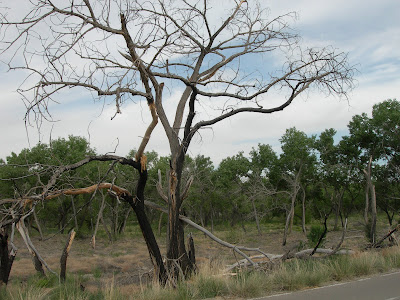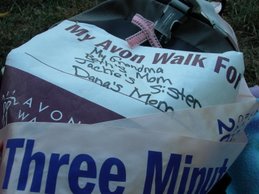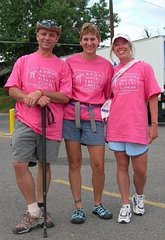
This is a great "motion shot" of us walking. This was pretty early in the morning at one of the first cheering stations. We were among the first people to leave Washington Park after the opening ceremony. We kept a really great pace in the morning and got to the lunch stop well before noon.

These were the signs at every drink stop. It was a great constant reminder to drink, drink, drink.

My Aunt Carol and my Mom made pink ribbons for the walk. Joel handed them out to people at cheering stations on Saturday and Sunday. The ribbons were a great support to me, I saw them over and over and over again on cheering people, bike riders who rode the route to help all the walkers, and on the crew members helping us cross the streets. Early on Saturday morning we were walking by a big group of people who were all wearing the ribbon. Joel told the people I had on an orange shirt and when they saw my orange shirt they cheered for us and said "thank you Valerie." It was like my family was there! It was so exciting to see so many people I didn't know wearing ribbons I knew my Aunt and Mom had spent time making. A beautiful gift.
Below is a great picture JM took of Joel handing out ribbons.

Below are two men I photographed at the closing ceremonies who had on their ribbons.


Joel handed out about 60 ribbons on Saturday and 20 on Sunday. He gave his last ribbon to a little girl who was cheering. As he handed her the ribbon, her sister who was younger came up to Joel and wanted a ribbon too. So he took off his ribbon and gave it to the little girl's sister.

The picture above and below are at the end of the day on Saturday. There was a camera guy at the finish line on Saturday - so my shoes walking down the path made it on to Denver's Channel 2 News. And there was also a wide shot of the finish line on the news. If you knew who you were looking for you could have seen Joel, JM, DeWayne, and Butch standing at the finish line. I love the picture below!

Joel took this picture of me when I was about .25 miles from the finish line at Washington Park.

Below is JM's picture of me coming in. I think I arrived at the park around noon. It was about 96 degrees.

JM and me at the finish.




Below is a picture of some Crew members writing on the towers. The towers go around the country to each walk. The current walk is at the bottom of the tower and then it moves up and the next city is moved to the bottom.


This is the screen at the closing ceremonies.

This is a picture of the Crew gathered for their final meeting. I was lucky and was standing near the Crew entrance at the closing ceremonies. I got to shake hands or high five nearly every Crew member. It was great to look so many people in the eyes and say "thank you!" The Crew is so important for the walkers. They set up the drinking stations, mix Gatorade by the hundreds of gallons, they force people to eat and drink when they aren't hungry or thirsty, they make the streets safe to cross, they guard the tent ground at night (Sean's Crew job), they serve food, the medical Crew give IVs to people who are dehydrated and tapes up feet and blisters. They do everything the walkers can't do for themselves.

This final picture is probably the most important. These are two of the charities receiving checks from some of the donations we collected. Here is information about the two charities who received checks:
Children's Treehouse Foundation (Denver, CO): received $125,000 to continue training, education and awareness programs that educate health experts and the public of the impact on children when a parent is diagnosed with cancer. These new funds will expand the number of hospitals involved in the Children’s Lives Include Moments of Bravery (CLIMB) training program, reaching 276 families affected by breast cancer. They will also help fund the National Training Seminars in Colorado and an annual regional seminar.
University of Colorado Cancer Center (Aurora, CO): received $750,000 to support continued research and outreach at the Avon Foundation Center at the University of Colorado Cancer Center. Funding supports research into the role of hormones in breast cancer and to better understand metastasis, as well as two community access programs: Survivorship Outreach to Latinas (SOL) and CoMadre Project, which will reach 5,000 women on breast cancer screening.

The walk was really powerful this year. One important thing that I knew last year (but couldn't put into words last year) is that the energy of the walk comes from an immense sense of gratitude. The walkers are grateful for the cheering crowds, the Crew, the honking cars. The Cheerers and Crew are grateful to the walkers. I don't mean grateful in a simple "thank you" kind of way. It is gratitude in a deep heartfelt way. There is a gratitude for each other's lives and actions that I have never experienced in any other circumstances. There is a deep knowledge that each person participating is depending on other people and giving to other people and taking from other people and no one is taking or giving more than they need.
Along with this there were several really powerful moments for me during the weekend. I like lists, so here is a list of the great things I hope to remember for a long time.
I wasn't planning to walk again next year, but now I don't know. The funds we raise for the walk are so important to families facing cancer, it is hard to not want to participate. The other element of the walk is raising awareness. If we can get one person to think for 2 extra minutes about going to the doctor when something seems wrong - and they make an appointment and cancer is caught early - it is hard to not want to participate.
I would love to Crew for the walk next year and offer training advice and encouragement to anyone who is interested. It is the experience of a lifetime!
































